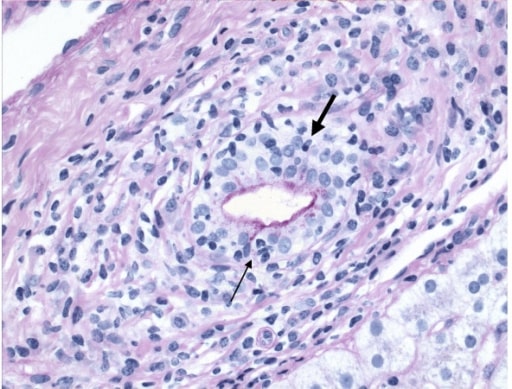Playlist
Show Playlist
Hide Playlist
Primary Biliary Cirrhosis
-
Slides GD liver disease.pdf
-
Download Lecture Overview
00:01 We're going to a second type of autoimmune disease causing damage to perhaps eventually the liver. 00:09 And this, then brings us to primary biliary cirrhosis. 00:11 First, dissect the name. 00:15 Primary, means to say there was no predisposed condition Biliary. With the biliary tree, you know that it begins or anatomically it originates in the liver. 00:28 Everything congregates down by the bile duct in zone 1. 00:31 And the bile duct then starts to come out of the liver and then start moving towards your gall bladder. 00:37 There is every possiblity that primary biliary cirrhosis that it could be an interhepatic. 00:41 or extra hepatic disease. 00:43 if it is interhepatic with primary biliary cirrhosis then you are looking for elevated liver function tests. 00:49 Here, you would find AMA. 00:51 Anti-mitochondria antibody which I will show you in a second. 00:53 And there is every possibility that you will have extra hepatic manifestation but because you have the biliary tree involved, understand that you will have an increase in, ALP, alkaline phosphatase. 01:07 Along with your liver function tests. 01:10 Affects women more so because it is autoimmune. 01:13 Symptoms include pruritus and fatigue. 01:17 Pruritus is itching. 01:19 and often times in primary biliary cirrhosis, you can expect to find jaundice. 01:24 So, often times there is jaundice, and there is pruritus could give you a couple of differentials. 01:30 Primary biliary cirrhosis is one of them. 01:32 I'll give you another one. 01:33 that often times students get confused with and that is Primary Sclerosing cholangitis. 01:38 They sound quite alike and if you are tired and fatigued, and you are taking an exam and you are on the 6th hour, please be careful. 01:45 Your mind is thinking one thing but your hand might choose something else. 01:48 Be alert at all times. 01:50 Make sure that you choose the answer that your mind is actually thinking. 01:57 PBC. Primary biliary cirrhosis. 01:59 95% of your patient will be AMA positive. 02:03 Anti mitochondrial Antibody positive. 02:06 You are not going to find this at all. 02:08 So, I'll make your life a little bit easier and as a differential primary sclerosing cholangitis we'll make sure we come up with a differential but here AMA positive In primary sclerosing cholangitis, AMA negative. 02:22 Here also, you'll find elevated Alkaline phospatase because the biliary tree is involved. 02:28 if your biliary tree is affected, I cannot effectively deliver, bile to the duodenum. 02:35 O-oh! What kind of food particles are affected. 02:39 You must have bile so that you can metabolize lipid. 02:45 Right? What's that process called? Emulsification. 02:49 If you don't have emulsification, what kind of vitamins do you think you are missing? Duh! Fat soluble vitamins. 02:54 ADEK, A-D-E-K. 02:57 Why is osteoporosis here? Which one of the fat soluble vitamins, if it's defficient may then lead into osteoporosis? That is vitamin D deficiency. 03:09 So fat soluble vitamins have been lost. 03:12 Or not properly absorbed. 03:14 Upon biopsy, You find granulomatous infiltration of bile duct granulomatous infiltration of bile duct Memorize that. 03:23 Know it. 03:25 Because in a little bit, when I talk about primary sclerosing cholangitis, Upon histology of the bile duct, You don't find granuloma, We call this, "onion-skinning" Management, Ursodeoxycholic acide and worst case scenario, if it is a little bit too late, and it's cirrhosis, the only option at this point will be liver transplantation.
About the Lecture
The lecture Primary Biliary Cirrhosis by Carlo Raj, MD is from the course Liver Diseases: Basic Principles with Carlo Raj.
Included Quiz Questions
Which antibody is usually positive for primary biliary cirrhosis?
- Antimitochondrial antibodies
- Antimicrosomal antibodies
- Anti-centromere antibodies
- Anti-SSA antibodies
- Anti-MPO antibodies
What is immunologically destroyed in primary biliary cirrhosis?
- Small bile ducts
- Portal vein
- Portal artery
- Central vein
- Hepatocytes
Which of the following is a complication of primary biliary cirrhosis?
- Osteoporosis
- Cholecystitis
- Pancreatic carcinoma
- Budd-Chiari syndrome
- Pigmented gallstones
Customer reviews
5,0 of 5 stars
| 5 Stars |
|
5 |
| 4 Stars |
|
0 |
| 3 Stars |
|
0 |
| 2 Stars |
|
0 |
| 1 Star |
|
0 |





